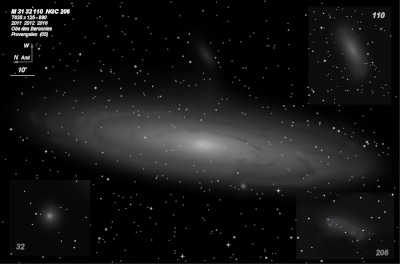Andromeda Galaxy
Andromeda Galaxy

Persian astronomer Abd-al-Rahman Al-Sûfi first mentioned M31 = NGC 224 = h51 in his "Book of Fixed Stars" (964 AD) as the "Little Cloud" lying before the mouth of a Big Fish (an Arabic constellation). Surprisingly, Tycho Brahe didn't mention M31 in his star catalogue (nor Hipparchus or Bayer), which included 6 nebulous objects (only real one was M44). German astronomer Simon Marius made the first telescopic observation of M31 (actually of any nebula) on 15 Dec 1612 and it appeared to be composed of rays of light, increasing in brightness towards the center, mared by a dull, pale light. It appearance "resembling the light of a burning candle, atsome distance, shining through translucent horn." Giovanni Hodierna listed it as a new nebula in his catalog based on his observation in 1654, so apparently he was unaware of Marius' observation in 1612. Cassini, in 1740, represented its shape as nearly triangular. Le Gentil considered it round for some years, then oval, but always of a uniform light. In 1764 Messier wrote "it resembles two cones or pyramides of light, opposed at their bases, the axes of which are in direction NW-SE." Due to these varying descriptions, it was thought the nebula might be variable.
William Herschel first observed M31 in 1780 ("has no star in it") but using a 6-inch on 2 Aug 1783 he noted, "227x, a strong suspicion of stars. This speculum has not light enough. I doubt not but 20 feet will confirm it. 460x, suspicion still stronger." He was obviously mistaken on the resolvability. WH also noted the nebula "begins to shew a faint red colour." Perhaps he detected a slight hue to the nuclear region (red giants), though this seems unlikely. In 1826 John Herschel wrote, "At present it has not, indeed, a star, or any well-defined disk in its center, but the brightness, which increases by a regular gradation from the circumference, suddenly acquires a great accession, so as to off the appearance of a nipple as it were in the midd, of very small diameter (10" or 12")...Its nebulosity is of the most perfectly milky absolutely irresolvable kind, with the slightest tendency to that separation into flocculi above described in the nebula in Orion..."
The quasi-stellar nucleus was observed by Johann Lamont on 13 Oct 1836 with a 10.5-inch refractor at Munich Observatory and measured as 6.9" diameter. George Bond made a remarkable sketch in 1847 using the new 15-inch Harvard refractor, showing two sharply defined dust lanes, a stellar nucleus and M32 and M110 embedded within the halo of M31. He mentioned "a sudden interruption of light, appearing like a narrow, dark band, in which the eye could detect no deviation from perfect straightness, streating, in the direction of the axis of the nebula, entirely across the field of view; exterior to this, with respect to the axis, was another band or canal..." Bond also traced the major axis to a length of 4°. Leopold Trouvelot produced a beautiful sketch of the dust lanes in 1874 at the Harvard College Observatory.
The spiral nature, though, was first revealed in photographs by Isaac Roberts in 1888 with a 20-inch reflector (reproduced in many publications) and E.E. Barnard in 1890 with the 12-inch refractor, though neither used in the word "spiral" in their papers. Roberts speculated wildly on the nature of M31, suggesting it was a "new solar system in the process of condensation from a nebula" and the two companions, M32 and M110, were "already undergoing their transformations into planets."
Ernst Hartwig discovered the first extragalactic supernova on 20 Aug 1885 near the center of M31. SN 1885A = S And reached mag 5.85 and faded to mag 14 a half a year later. The brightness (if a nova) seemed evidence that M31 was relatively nearby (within the Milky Way). In 1899, though, German astronomer Julius Scheiner obtained a spectrum using a 7.5 hour exposure and found "No traces of bright nebular lines are present, so that the interstellar speace in the Andromeda nebula, just as in our stellar system, is not appreciably occupied by gaseous matter." He further stated "previous suspicion that the spiral nebulae are star clusters is now raised to a certainty, the thought suggests itself of comparing ..our stellar system, with especial reference to its great similarity to the Andromeda nebula." This added strong support for the "island-universe" theory. Hubble first identified a Cepheid variable (V1) in M31 on a plate taken October 5-6, 1923. In 1944, while the Los Angeles area was in a World War II blackout, William Baade first resolved the central region of M31, M32, M110 as well as NGC 147 and NGC 185 using the 100-inch at Mount Wilson.
400/500mm - 18" a total of 38 globular clusters have been tracked down in M31 as well as 9 star clusters.
Notes by Steve Gottlieb